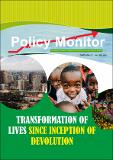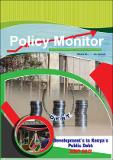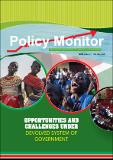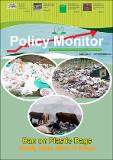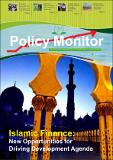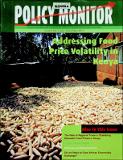KIPPRA Policy Monitor / Newsletters: Recent submissions
Now showing items 21-40 of 41
-
Policy Monitor, Issue 11 No. 2, October-December 2019 on Inclusion of Persons with Disabilities in National Development for Shared Prosperity
(The Kenya Institute for Public Policy Research and Analysis (KIPPRA), 2019)This edition focuses on the important and sensitive topic of Inclusion of Persons with Disabilities in National Development for Shared Prosperity. We explore and delve in topics covering Inclusion of Persons with Disabilities ... -
Policy Monitor, Issue 10 No. 3, January-March 2019 on Transformation of Lives Since Inception of Devolution
(The Kenya Institute for Public Policy Research and Analysis (KIPPRA), 2019)This edition highlights Kenya's economic performance with updated medium-term projections for economic growth. given the sustained macroeconomic stability, improved business and investor confidence, continued public ... -
Policy Monitor, Issue 10 No. 1, July-September 2018 on Development's in Kenya's Public Debt 2007-2017
(The Kenya Institute for Public Policy Research and Analysis (KIPPRA), 2018)During this Quarter, the institute engaged stakeholders in various forums including Policy seminars, dissemination workshops and the Launch of KIPPRA Mentorship Programmes for Universities. Kenya’s economic growth during ... -
Policy Monitor, Issue 9 No. 4, April-June 2018 on Building Resilience to Droughts and Floods
(The Kenya Institute for Public Policy Research and Analysis (KIPPRA), 2018)After many years, the Institute successfully hosted the KIPPRA Regional Annual Conference from 5th-7th June 2018 whose theme was “Building Resilience to Mitigate the Effects of Droughts and Floods”. The conference attracted ... -
Policy Monitor, Issue 10 No. 2, October-December 2018 on Opportunities and challenges Under Devolved System of Government
(The Kenya Institute for Public Policy Research and Analysis (KIPPRA), 2018)This edition mainly focuses on the opportunities and challenges of devolution in the country. it delves into some experiences of devolved units in Kenya including county expenditures, own county revenues and county pending ... -
Policy Monitor, Issue 9 No. 3, January-March on Realizing the "Big Four" Agenda through Energy as an Enabler
(The Kenya Institute for Public Policy Research and Analysis, 2018)On 12th December 2017, His Excellency President Uhuru Kenyatta announced his new plan, the ‘Big Four’, which will guide the development agenda of the country in the period 2018-2022. It focuses on key basic needs that ... -
Policy Monitor, Issue 9 No. 1, July-September 2017 on Ban on Plastic Bags Finally Takes Effect in Kenya
(The Kenya Institute for Public Policy Research and Analysis (KIPPRA), 2017)The recent data released by the Kenya National Bureau of Statistics (KNBS) indicates slower economic activity in the first half of 2017 compared to a similar period in 2016. This is mainly attributed to adverse weather ... -
Policy Monitor, Issue 8 No. 4, April-June 2017 Islamic Finance: New Opportunities for Driving Development Agenda
(The Kenya Institute for Public Policy Research and Analysis (KIPPRA), 2017)Welcome to the April-June 2017 edition of KIPPRA Policy Monitor. The lead articles in this edition cover recent Kenya economic developments and prospects with a detailed focus on inflation dynamics given the prevailing ... -
Policy Monitor, Issue 9 No. 2, October-December 2017 on Taming the Road Safety Challenge through Effective Policy Response
(The Kenya Institute for Public Policy Research and Analysis (KIPPRA), 2017)Welcome to the October-December 2017 edition of the KIPPRA Policy Monitor. Market confidence is gradually holding after a prolonged electioneering period that spilled over into the fourth quarter of the calendar year 2017. ... -
Policy Monitor, Issue 8 No. 2, January-June 2016 on Improving Public Policy Making for Economic Growth and Poverty Reduction
(The Kenya Institute for Public Policy Research and Analysis (KIPPRA), 2016)In this issue of the Policy Monitor, we take a detailed look at various dynamics in a number of sectors and sub-sec- tors of Kenya’s economy. The first article takes an overview of the macro trends of the economy, considering ... -
Policy Monitor, Issue 7 No. 2 January-June 2015 on Supremacy Wars Between State Agencies in Kenya Could Compromise Good Governance
(The Kenya Institute for Public Policy Research and Analysis (KIPPRA), 2015)Although each arm of government is independent of the other, the three are designed such that their functions complement and check on the excesses of the other. Good governance is compromised when either arm of ... -
Policy Monitor, Issue 6 No. 2, July-December 2015 on Role of Counties in Kenya's Trade Development
(The Kenya Institute for Public Policy Research and Analysis (KIPPRA), 2015)The lead article in this issue of the Policy Monitor discusses the dynamics of trade, especially in the new constitutional dispensation that saw the creation of counties. Being a critical factor in the country’s economic ... -
Policy Monitor, Issue 7 No. 1, July-December 2014 on Improving public policy making for economic growth and poverty reduction
(The Kenya Institute for Public Policy Research and Analysis (KIPPRA), 2014)With the many cases of insecurity that have plagued Kenya in the recent past, a number of articles in this issue of the Policy Monitor address various aspects of insecurity and what the government can do to stop ... -
Policy Monitor, Issue 6 No. 1, July-December 2013 on Devolution is more than "Equitable" Sharing of National Resources
(The Kenya Institute for Public Policy Research and Analysis, 2013)There is a skewed perception in Kenya today that devolution is just about “equitable” sharing of national resources. This perception of devolution has its roots. The emotions and passions that energized Kenyans to ... -
Policy Monitor, Issue 4 No. 2, January-June 2012 on An Assessment of Kenya's Financial Governance
(The Kenya Institute for Public Policy Research and Analysis (KIPPRA), 2012)I /enya participated in a IK pilot exercise leading I \to the roll out of the African Governance Outlook (AGO), a new flagship report on financial governance in Africa. The report, which is a flagship publication ... -
Policy Monitor, Issue 5 No. 1, July-December 2012 on Addressing Food Price Volatility in Kenya
(The Kenya Institute for Public Policy Research and Analysis (KIPPRA), 2012)Kenya is a low-income country with a GOP per capita estimated at USS 775. Agriculture is a major economic activity. Currently, one out of every four Kenyans suffers from chronic food insecurity and poor nutrition. ... -
Policy Monitor, Issue 4 No. 1, July-September 2011 on Unemployment in Kenya
(The Kenya Institute for Public Policy Research and Analysis (KIPPRA), 2011)In many countries, long term unemployment and underemployment continue to soar. The unemployment rate of youth agl'd 15-24 in Kenya was 24% in 2005/6 compared to the overall unemployment rate of 12.7%. Under-employment ... -
Policy Monitor, Issue 1 No. 3, January-March 2004 on Kenya's Domestic Debt: Risks and the Challenge of Sustaining Recent Economic Gains
(The Kenya Institute for Public Policy Research and Analysis, 2004)One of the fundamental public goods that a government can provide to its citizens is a stable macroeconomic environment supported by prudent fiscal policies. Prudent fiscal policies enable the government to, among other ... -
Policy Monitor, Issue 2 No. 4, April 2004-June 2005 on Kenya's Participation in International Trade Negotiations
(The Kenya Institute for Public Policy Research and Analysis, 2004)Trade negotiations play a key role in increasing international market access for exports. Kenya has pursued global integration through trade with other countries at regional and international level. The main aim in ... -
Policy Monitor, Issue 1 No. 2, October-December 2003 on Building and Construction Yet to Provide Impetus to Economic Recovery
(The Kenya Institute for Public Policy Research and Analysis (KIPPRA), 2003)One of the Government of Kenya's policy objectives is to put in place sound macroeconomic policies to achieve economic and social targets. Fiscal and monetary policies are two instruments, among others, whose design ...


